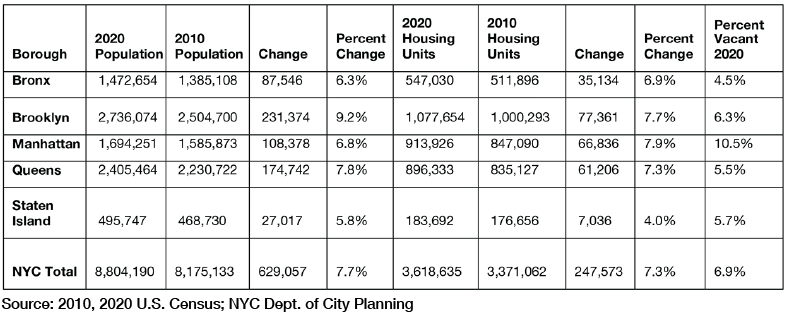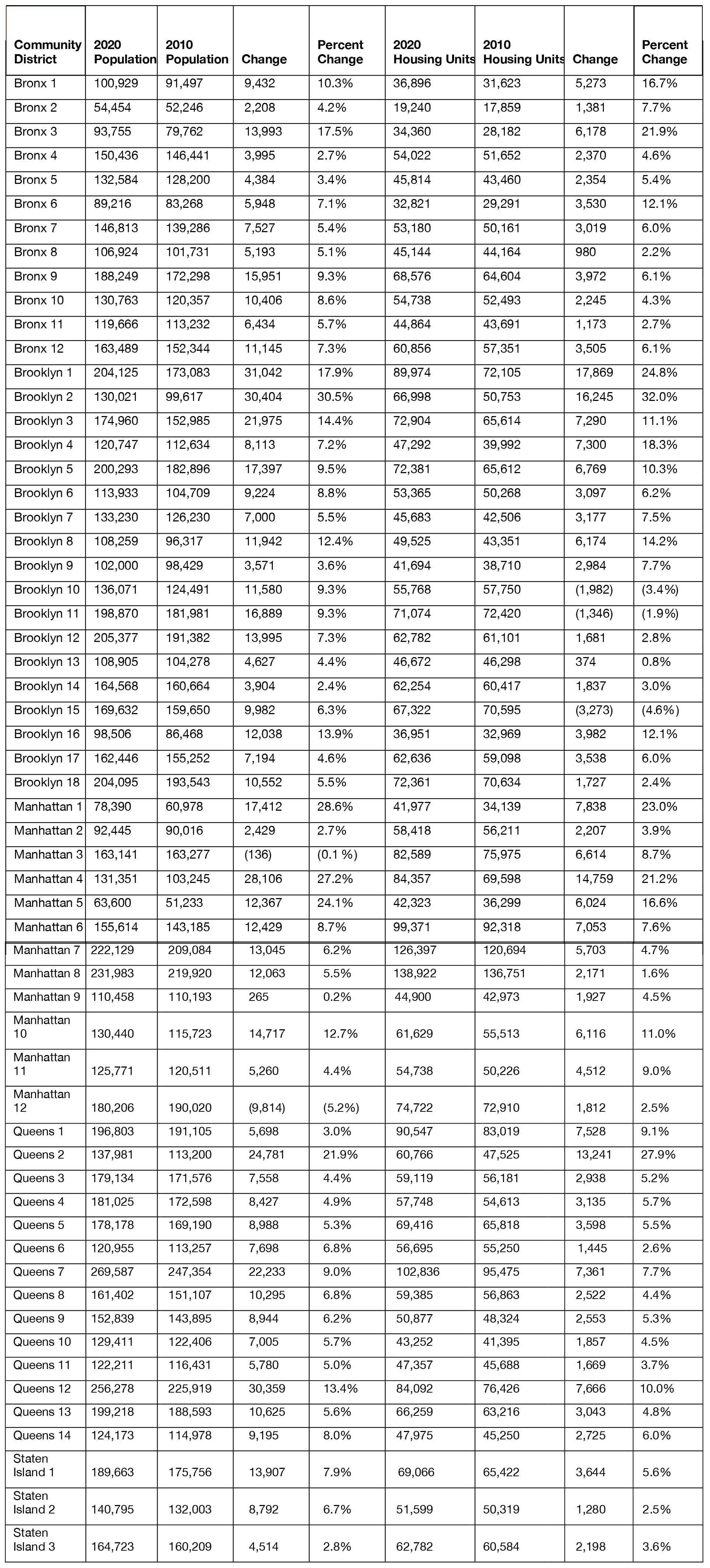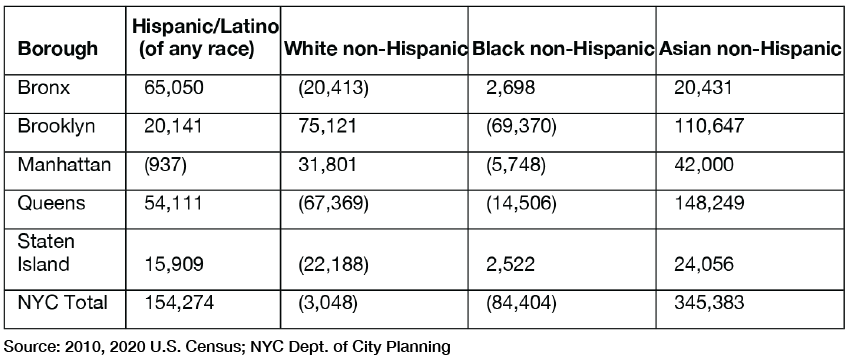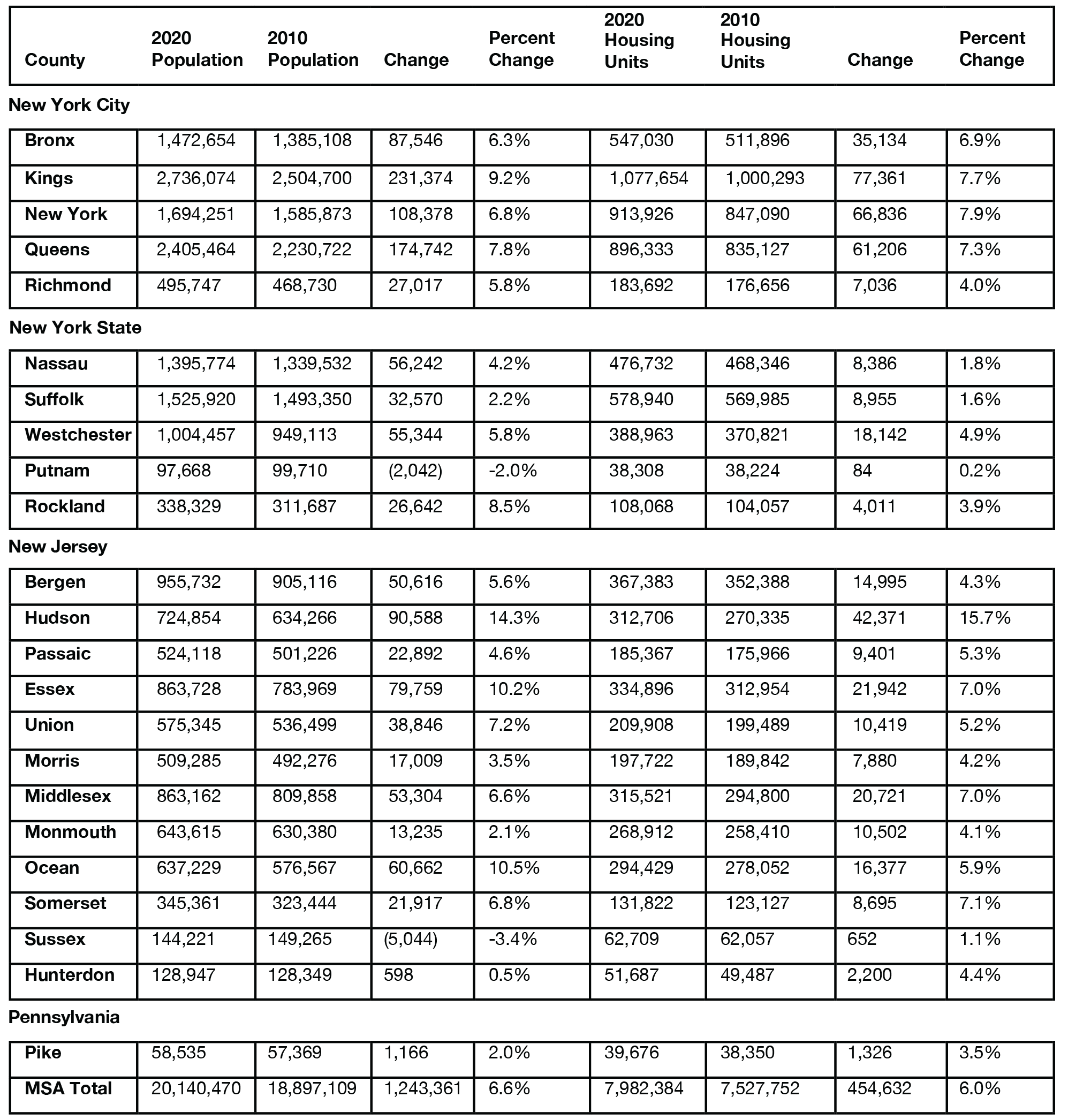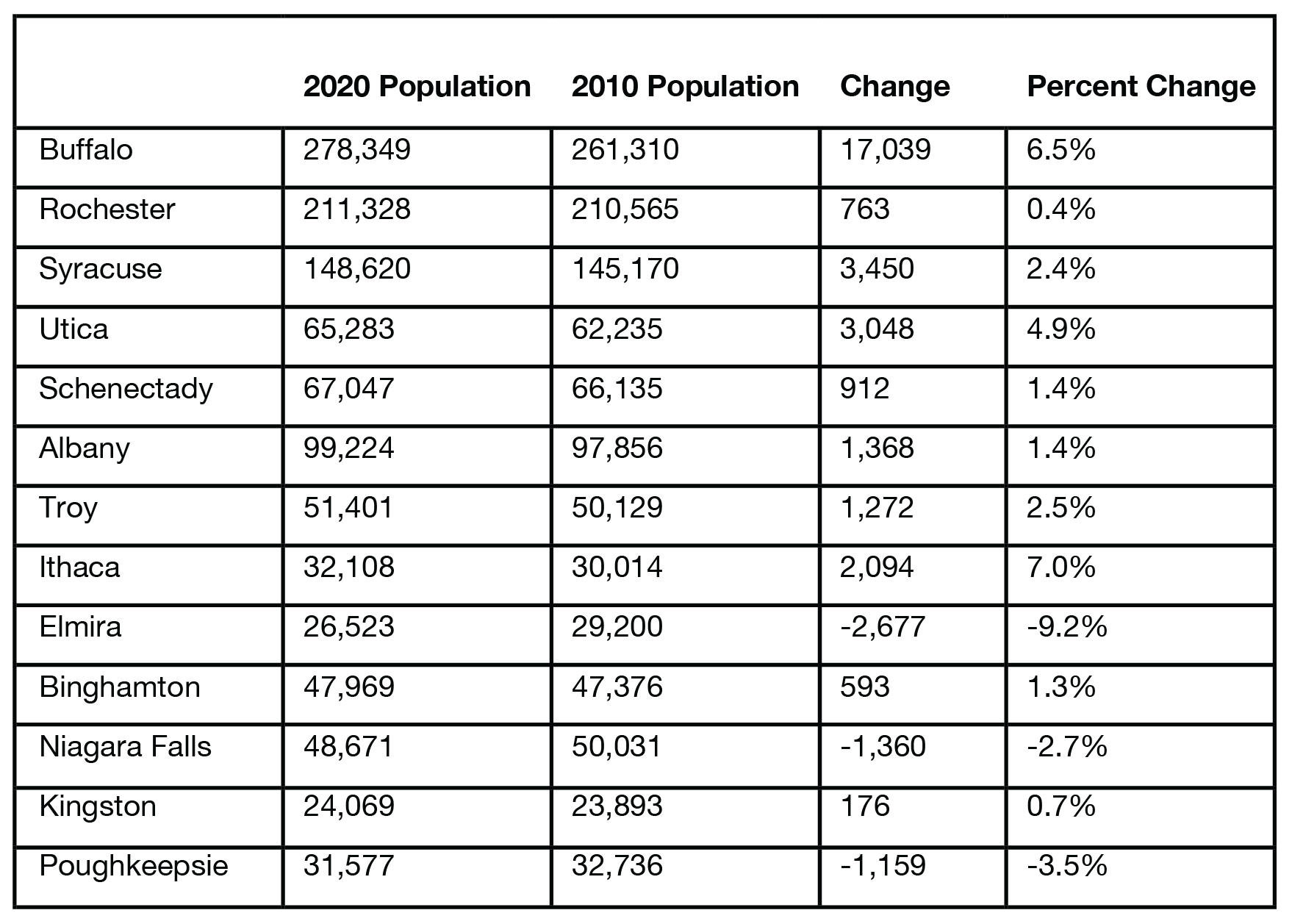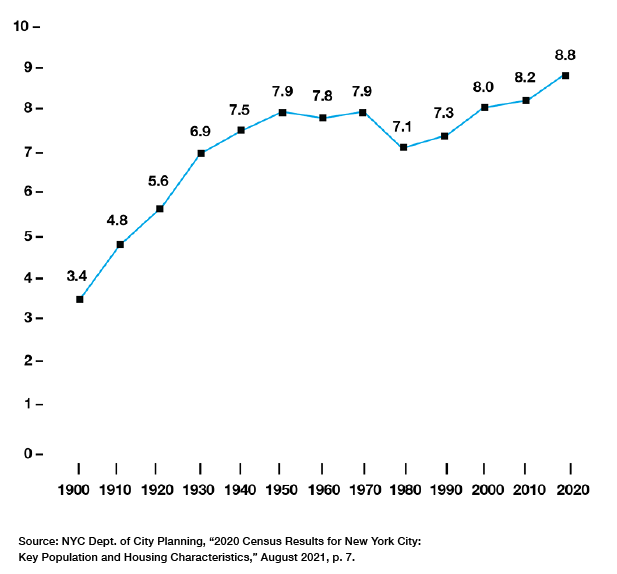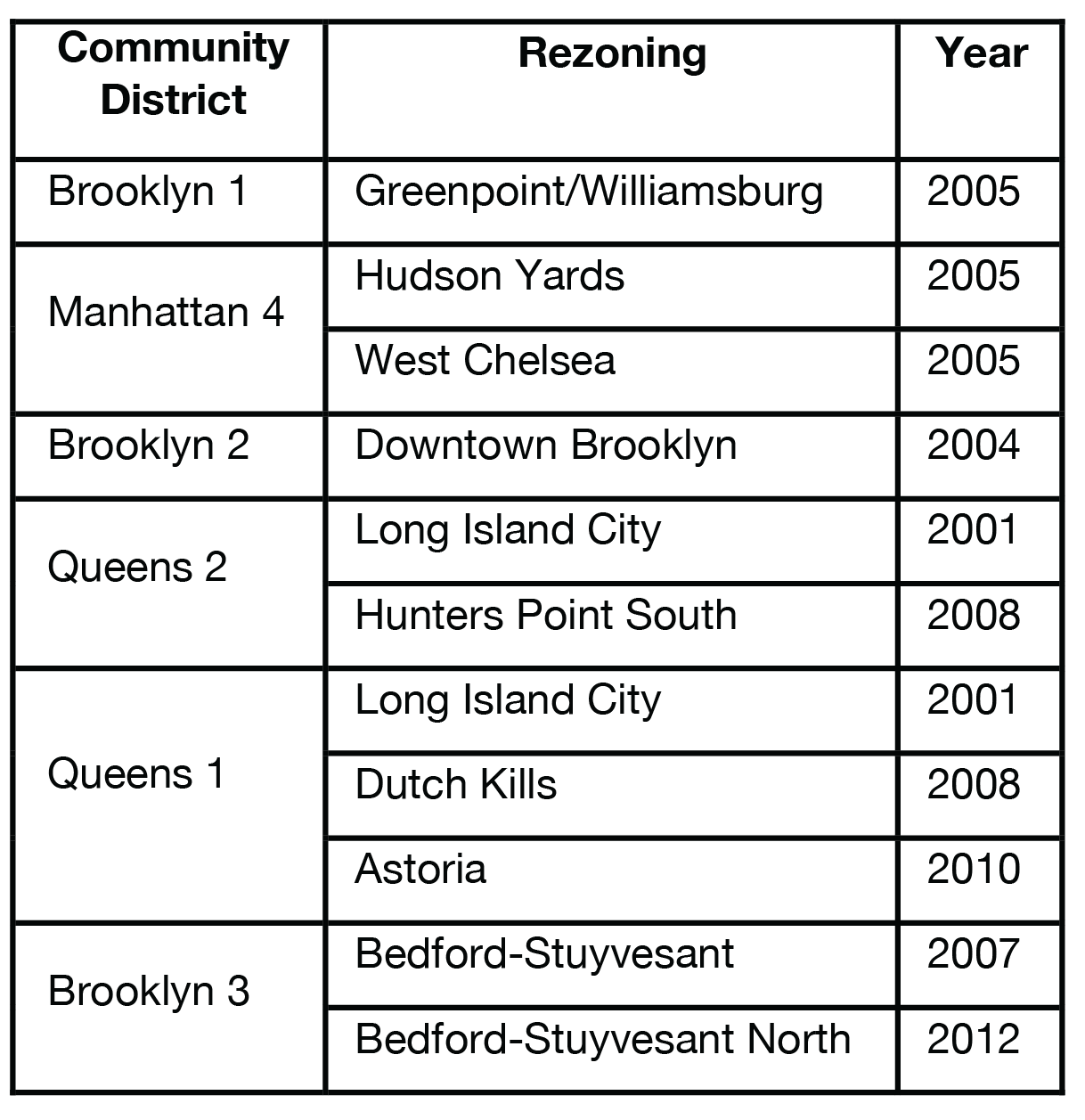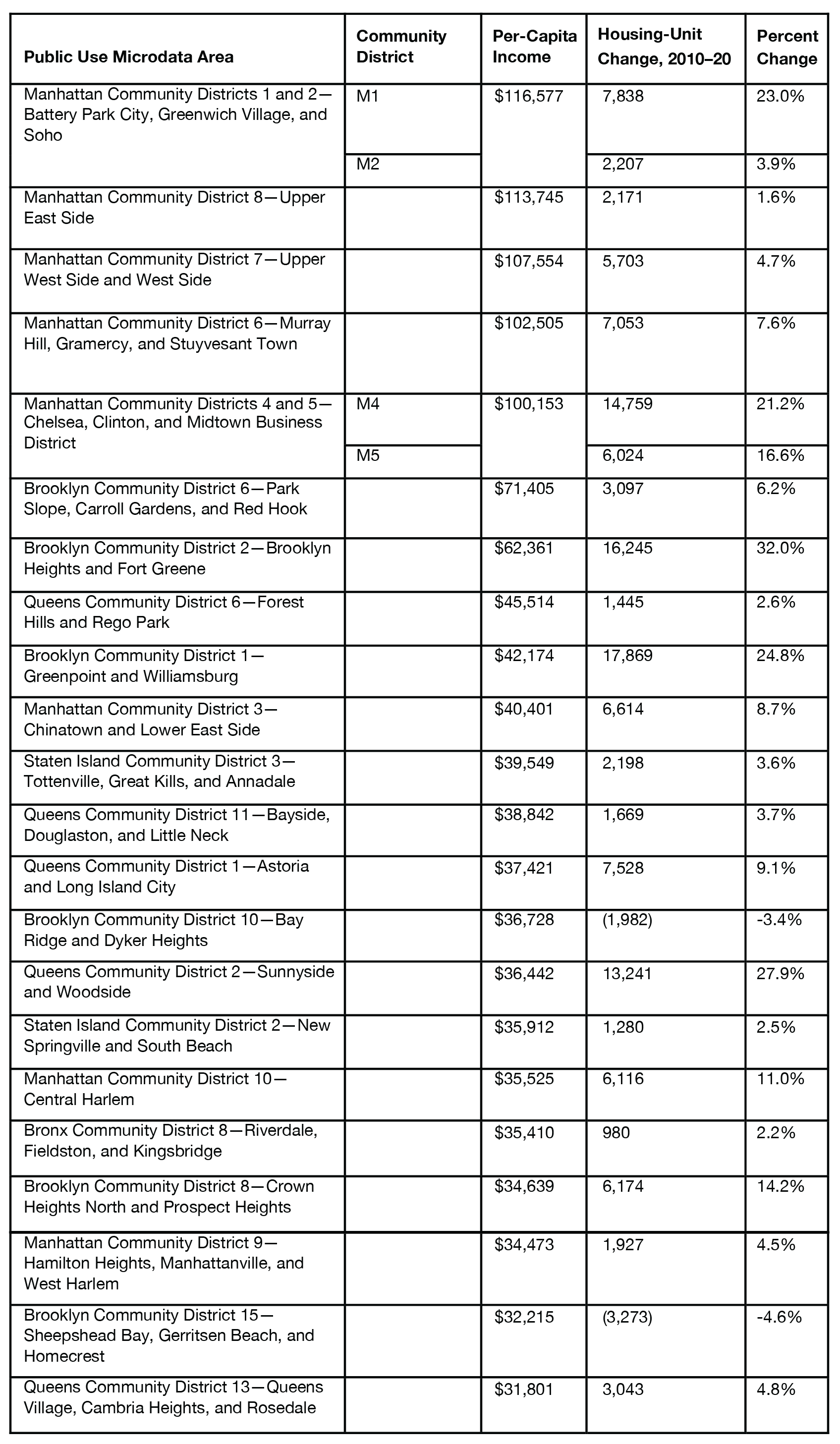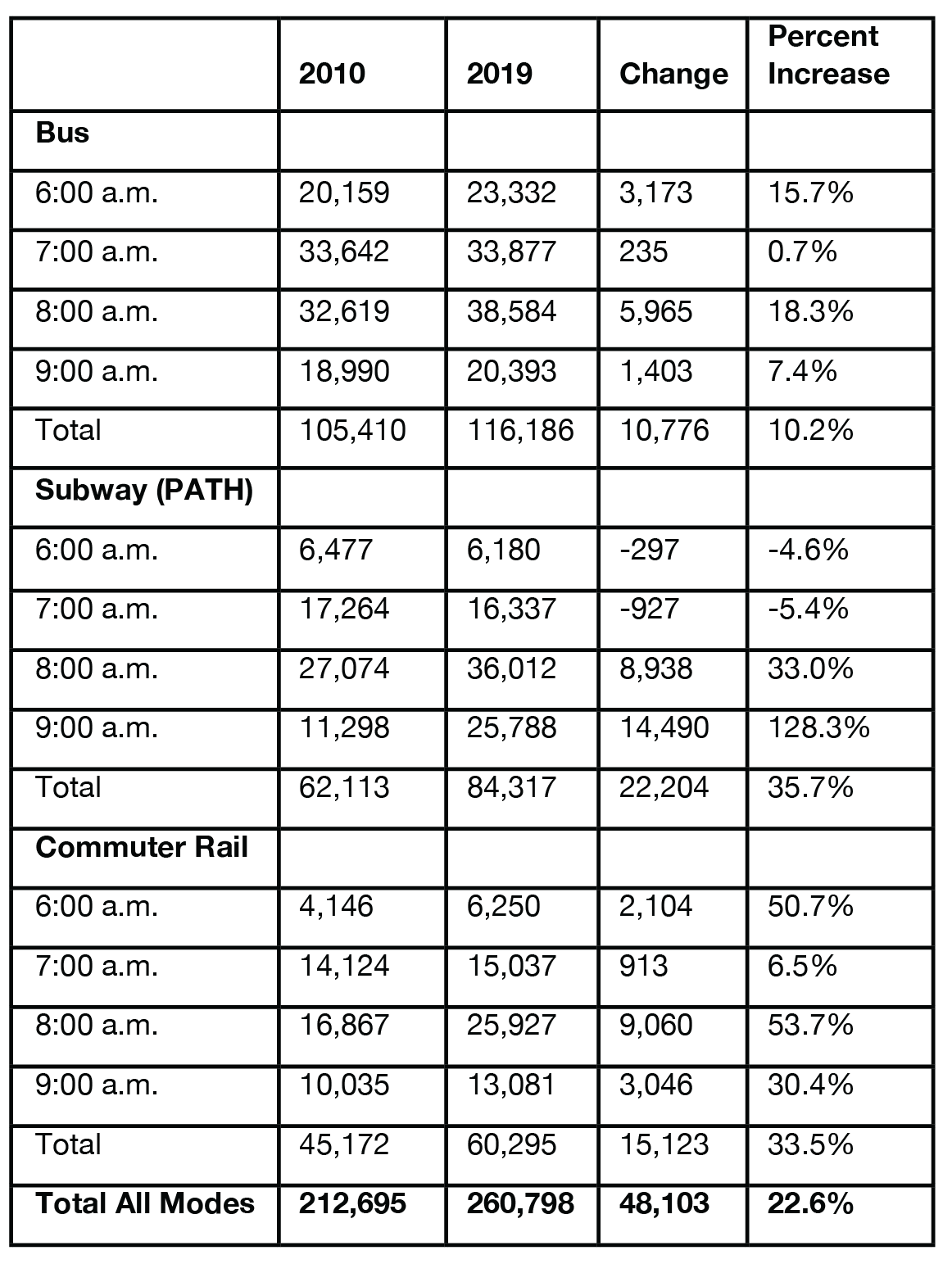Can’t Keep a Great City Down: What the 2020 Census Tells Us About New York
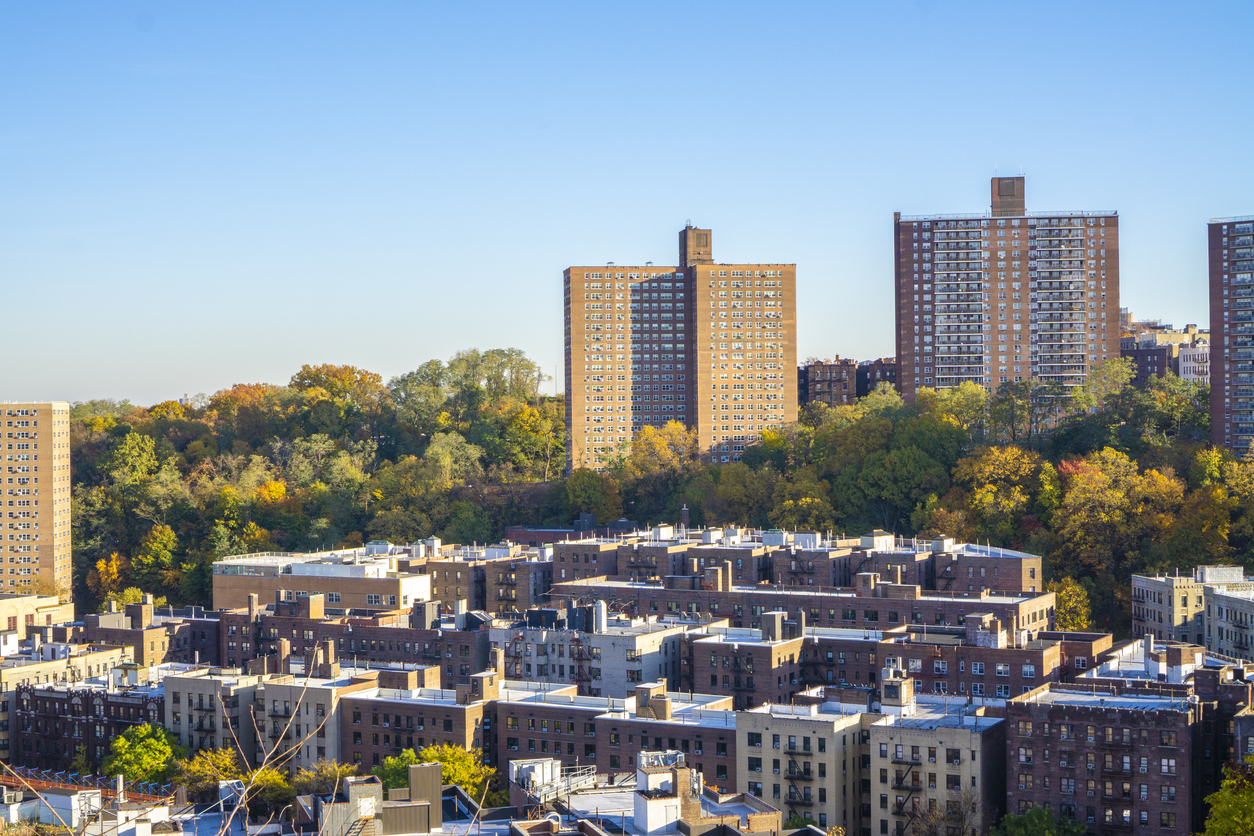
Results from the 2020 census confirmed that New York City’s population grew significantly in the decade up to 2020, by 629,000. Spurred by a long economic boom, the city’s population growth happened via natural increase, the excess of births over deaths. Contrary to the Census Bureau’s pre-census population estimates, which had projected significant population drops at the end of the decade due to growing net out-migration, about the same number of peoplemigrated to the city, either domestically or internationally, as left during the decade.
The census also revealed unexpectedly large housing gains for NYC during 2010–20, exceeding the amount of net new construction—completions minus demolitions—reported by the citybetween 2010 and 2020. The difference in the two sets of numbers may have resulted from better census-taking, methodological differences in counting housing completions, or construction without permits. However, even the census-reported housing growth was not sufficient to alleviate the city’s chronic housing shortage because the population continues to grow.
Within the city, population growth was uneven; a small number of the city’s 59 community districts had large gains while many other districts grew little. The top-growing districts correlated in many cases with large-scale rezonings carried out under Mayors Rudolph Giuliani and Michael Bloomberg. Many other community districts could attract private housing investment, based on average incomes and market conditions, but are restrictively zoned or have other curbs on new housing construction such as historic districts. The next mayor needs to implement zoning changes that distribute the burden of meeting the city’s housing demand more equitably.
Northern New Jersey municipalities did the city a considerable favor by accepting a disproportionate share of the region’s population and housing growth. The 2020 census identifies the emergence of a de facto growing “sixth borough” centered on Hudson County, New Jersey, but also including the more densely urbanized portions of adjoining counties. To solidify regional prosperity, New York and New Jersey officials need to make further progress in upgrading the transit infrastructure serving this aggregation of communities and connecting them with Manhattan.
In contrast, New York suburbs, particularly on Long Island, underperformed the city, let alone their New Jersey counterparts, in accommodating regional growth. The larger Westchester cities are promising exceptions to this trend. New York State needs to consider adopting some of the land-use reforms that other states have used to overcome resistance to new housing in affluent suburbs.
New York City, primarily, and a few downstate suburban counties accounted for nearly all the state’s population gains in the 2020 census. Upstate New York as a whole lost population, particularly in rural areas, which is part of a national trend. However, in a reversal of earlier trends, the larger upstate cities, particularly Buffalo, posted population gains.
Introduction
Confounding the U.S. Census Bureau’s own estimates, New York City recorded a population gain of 629,057 between 2010 and 2020. The city’s 7.7% population increase, to 8,804,190, is the second-largest numerically in the past nine decades, surpassed only by 1990–2000, when the enumerated population increased by 686,000.
The Census Bureau had previously issued an estimate of New York City’s population for July 2020 of 8,253,213, only a 1% increase from 2010. [1] The bureau’s estimates had the city’s population peaking at 8.469 million in 2016 and trailing off in subsequent years.
How could these estimates be so far off? The Census Bureau’s population estimates are built by summing the components of population change. These are the natural increase (births minus deaths), which are compiled from administrative records; and net migration, both international and domestic. The Census Bureau also uses administrative records to estimate migration, but these records provide a less accurate picture than the city’s vital records do of births and deaths.
New York City’s natural increase from the last census date of April 1, 2010, to July 1, 2020, was 611,532. For the Census Bureau’s 2020 population estimate to be accurate, net migration would have had to be sharply negative—a net outflow of 532,477. In fact, it turns out to have been slightly positive, at least up to the census date of April 1, 2020.
The notion that New York City was rapidly losing population caused considerable hand-wringing in the latter part of the 2010–20 decade. A December 2020 Bloomberg Wealth article, for example, declared: “New York City . . . was losing 376 residents per day to domestic migration in 2019—an increase of more than 100 per day from the previous year—before it became the epicenter of the country’s virus outbreak in March this year, according to the U.S. Census Bureau’s latest survey of population shifts.” [2]
That this was not, in fact, happening is unalloyed good news for New Yorkers and, indeed, for the nation, which benefits from the city’s economic output and cultural innovation. New York City has many challenges, but population decline is not one of them.
A recent commentary by Bloomberg Opinion columnist Noah Smith gets at the fundamental reasons for this:
- [P]eople move to New York because that’s where the jobs are, and jobs move to New York because that’s where the skilled workers are. For New York to go into a sustained decline would take a massive catastrophe—something big enough to remove the nucleus of companies and skilled workers completely. Covid simply wasn’t that. [3]
The 2020 census also recorded a record-high population in the Bronx, of 1,472,654. The borough has more than made up for the losses that occurred subsequent to the previous peak in 1970. The recovery of the borough, so implausible to those who remember when President Jimmy Carter visited the desolate Charlotte Street neighborhood of the South Bronx in 1977, [4] was the work of innumerable elected officials, community activists, business owners, landlords, and ordinary residents who worked incrementally to improve communities.
This paper reviews key takeaways from the New York City data released by the Census Bureau in August 2021. [5] The paper then looks at what the census tells us about the city’s relationship to its region [6] and to the State of New York. Finally, it looks at the implications for some of the policy issues faced by the next mayor of New York City and the governor of New York State, legislators, and public officials.
New York City in 2020
Brooklyn had the largest population of any borough in 2020 (2,736,074) and the largest population gain from 2010 (231,374) (Figure 1). Brooklyn, which also suffered large population losses after 1970 and dramatically recovered, is just short of its record population of 2,738,175 in 1950. Queens is the second-most-populous borough (2,405,464) in 2020, and had the second-largest gain from 2010 (174,742). For Queens, the 2020 census once again represents a record population, as did the censuses in 2000 and 2010.
Manhattan was the third-largest borough in 2020, with a population of 1,694,251. Manhattan gained 108,378 residents between 2010 and 2020, a rate of growth of 6.8%, slightly below the citywide average. Manhattan’s population peaked in 1910 at 2,331,542, a time in which it was considered intolerably crowded. An important objective in consolidating New York City’s five boroughs and constructing its subways was to disperse Manhattan’s population. However, the borough remains below its 1960 population of 1,698,281. Staten Island also achieved a record population of 495,747, growing by 27,017 since 2010. Heavily protected by restrictive zoning, Staten Island grew far less than adjoining New Jersey counties.
Figure 1
New York City Population and Housing-Unit Change by Borough
New York City is divided administratively into 59 community districts (CDs; see map in Appendix). These districts varied widely in terms of population gain (Figure 2). Three community districts (Brooklyn 1 and 2 and Queens 12) gained more than 30,000, and four (Brooklyn 3, Manhattan 4, and Queens 2 and 7) gained more than 20,000. At the other end of the spectrum, Manhattan Community District 9 gained only 265 people, and in the same borough, Districts 3 and 12 lost population (drops of 136 and 9,814, respectively). In addition to Manhattan 9, eight community districts had population gains under 5,000 between 2010 and 2020: Bronx 2, 4, and 5; Brooklyn 9, 13, and 14; Manhattan 2; and Staten Island 3.
Figure 2
New York City Population and Housing-Unit Change by Community District
According to the 2020 census, New York City gained 247,573 housing units between 2010 and 2020, a gain of 7.3% (Figure 1). While this is slightly less than the rate of increase in population, because the number of vacant units decreased while “group quarters” [7] population increased, the average number of persons per household [8] decreased slightly, from 2.57 to 2.55 (“group quarters” accommodations are not counted as housing units for census purposes).
The change in housing units over the decade reported by the 2020 census significantly exceeds the number of new units, net of demolitions, documented by the city’s Department of City Planning (DCP) (205,994) in a February 2021 brief. [9] Some of the disparity may come from the slightly different time frames (the department’s figures are from January 2010 to June 2020, while the Census Bureau’s are from April 1, 2010, to April 1, 2020). Additionally, the collaborative effort between the city and the Census Bureau to improve the address list for mailing out the 2020 census forms may have resulted in the inclusion of some units that existed, but that were missed, in 2010. Finally, the census may have uncovered some units that were constructed during the decade without proper permits, typically through the subdivision of existing small homes into two or more units.
As with population, Brooklyn had the largest increase in housing units: 77,361. Manhattan was second (66,836), followed by Queens (61,206), the Bronx (35,134), and Staten Island (7,036).
The number of vacant units [10] fell in four of the five boroughs (Figure 3). New York City had challenged the results of the 2010 census, unsuccessfully, on the grounds that disproportionate and unexplainable increases in the count of vacant units had occurred in tracts enumerated by two local census offices—one in southern Brooklyn and the other in northern Queens. The city argued that a breakdown in census procedures had resulted in a failure to identify occupant households, resulting in an undercount of population. [11] The large drops in vacant units in Brooklyn and Queens (15,587 and 5,887, respectively) may reflect better census-taking in 2020. By contrast, Manhattan had a large increase, 12,900, in vacant units. The increase in vacancies is concentrated in five community districts: 2, 3, 5, 6, and 7, each of which added more than 2,000. This may reflect more housing units that are nonprimary residences or transient units.
Figure 3
Vacant Housing Units by NYC Borough
The number of additional housing units also varied widely by community district, as shown in Figure 2. Four CDs had an increase of more than 10,000: Brooklyn 1 (17,869), Brooklyn 2 (16,245), Manhattan 4 (14,759), and Queens 2 (13,241). These four CDs had much of the largest housing-unit change in the DCP brief from February 2021 as well. The census shows seven additional CDs that added more than 7,000 additional housing units: Brooklyn 3 and 4; Manhattan 1 and 6; and Queens 1, 7, and 12. Some of these (Brooklyn 3 and 4; Manhattan 1; and Queens 1) also ranked high in the DCP brief. Others (Manhattan 6 and Queens 7 and 12) were believed to have had only moderate housing growth, in the range of 4,000 new units, according to DCP.
Three Brooklyn community districts lost housing units, perhaps as a consequence of reversed subdivisions, in which homes that previously had a rental unit are reconverted to single-family: 10 (–1,982), 11 (–1,346), and 15 (–3,273). Thirteen community districts gained fewer than 2,000 units: Bronx 2, 8, and 11; Brooklyn 12, 13, 14, and 18; Manhattan 9 and 12; Queens 6, 10, and 11; and Staten Island 2. An additional 10 districts gained 2,000–3,000 units.
The 2020 census redistricting file includes full-count race and Hispanic origin data for the city’s population. When analyzing such data, it is important to keep in mind that these characteristics are self-described; since many people have ancestry from more than one race or Hispanic origin category, the same person may respond differently from one census to another.
That noted, in 2020 New York City recorded a large increase in its Hispanic and Asian non-Hispanic populations (154,274 and 345,383, respectively; see Figure 4). The white non-Hispanic population decreased slightly, by 3,048, while there was a larger decrease in the black non-Hispanic population of 84,404. Any conclusions that one may draw from these data are complicated by the concurrent increases in “some other race, non-Hispanic” of 65,569 and “non-Hispanic of two or more races” of 151,283.
Figure 4
Change in Race and Hispanic Origin
2010 and 2020
The largest drop in the black non-Hispanic population (69,370) occurred in Brooklyn, where the white non-Hispanic population increased by 75,121. This might seem a straightforward story of private-market real-estate development leading to “gentrification” as wealthier white non-Hispanic newcomers displaced less affluent black non-Hispanic households, [12] but an examination of the community district data (Appendix, Figure 1) tells a more complicated story.
The five Brooklyn community districts with the largest drops in black non-Hispanic population were 3, 8, 9, 14, and 17. In District 3, the third-fastest-growing, the black non-Hispanic population fell by 22,104, while the white non-Hispanic population rose by 29,958. In District 8—slower-growing in terms of population but showing nearly as large an increase in housing units as CD 3—the black non-Hispanic population fell by 13,406 while the white population increased by 15,021. In these community districts, racial change seems to be concurrent with surging real-estate development.
But in other community districts with large black non-Hispanic population drops, there is no relationship to housing growth. In District 9, housing units increased by fewer than 3,000, but the black non-Hispanic population decreased by 14,151, while the white non-Hispanic population increased by 9,707. In District 14, also with little housing growth, the black non-Hispanic population decreased by 10,503, while the white non-Hispanic population grew by just over 2,000; the largest-growing race and ethnic groups were Asian non-Hispanics and non-Hispanics of two or more races. District 17, another low-housing-growth area, experienced a drop of 9,954 in black non-Hispanics. Its largest growth group was non-Hispanics of two or more races, which increased by 8,192.
Fast-growing community districts in Brooklyn and other boroughs, including Brooklyn 1, Manhattan 4, and Queens 2, had small increases in the black non-Hispanic population. In Queens 12, which also grew significantly, there was a drop of 9,331 in the black non-Hispanic population. At the same time, white non-Hispanics hardly increased, but there was a large increase, of 18,779, among Asian non-Hispanics.
In short, the way in which the racial composition of the city changed was not uniform, but varied across neighborhoods. The common gentrification narrative—in which market real-estate development drives up prices to the detriment of minorities, especially blacks—is plausible only in some community districts. In other parts of the city, rapid growth in the housing stock led to population increases for all racial and ethnic groups. And in another group of communities, there were sharp changes in racial and ethnic composition but little growth in the housing stock.
In 2020, New York City was 30.9% white non-Hispanic. However, 15 community districts were more than 50% white non-Hispanic: Brooklyn 1, 6, 10, 12, 13, and 15; Manhattan 1, 2, and 4–8; and Staten Island 2 and 3. In many of these districts, the white non-Hispanic population declined, while the share of other groups increased. For example, Staten Island Community District 3, with the highest white non-Hispanic population share, at 78.4%, nonetheless experienced a reduction of 7,669 in its white non-Hispanic population while gaining Hispanics, Asian non-Hispanics, and a very small number of black non-Hispanics.
The City in the Region
The New York, Newark, Jersey City, NY–NJ–PA Metropolitan Statistical Area (MSA) [13] had a population of 20,140,470 in 2020, an increase of 1,243,361 over 2010. New York City thus had about half the population increase in the MSA but only 43.7% of total 2020 population.
Of the New York counties in the MSA, only Rockland had faster population growth than the city: 8.5% (Figure 5). [14] Nassau and Suffolk grew just 4.2% and 2.2%, respectively, and had even lower housing-unit growth. Westchester grew somewhat more—5.8%—in population and 4.9% in housing. Putnam County’s population fell by 2%.
Figure 5
New York-Newark-Jersey City, NY-NJ-PA Metropolitan Statistical Area
Changes in Population and Housing Units by County, 2010–20
Westchester’s growth was led by its cities (Appendix, Figure 2). Mount Vernon’s population grew by 9.8% and that of Yonkers by 8%. White Plains and New Rochelle grew by 4.8% and 3.5%, respectively.
Some New Jersey counties contributed much more to regional growth. Hudson County had a population increase of 90,588, or 14.3%; its housing stock grew by 15.7%. Essex grew by 79,759, or 10.2%, and Ocean by 60,662, or 10.5%. Other New Jersey counties in the MSA, and Pike in Pennsylvania, grew more slowly than did the city. Sussex County in New Jersey lost population.
In Hudson County, the cities with the highest growth were Jersey City (44,852, or 18.1%) and Hoboken (10,414, or 20.8%). Bayonne grew by 8,662, or 13.7%. Some smaller Hudson County municipalities had even higher percentage growth: Harrison (42.8%), Weehawken (37%), and Secaucus (36.4%). Continuing the strong growth along the west shore of the Hudson River opposite Manhattan, Edgewater in Bergen County grew by 2,823, or 24.5%, and Fort Lee by 4,846, or 13.7%.
In Essex County, Newark grew by 34,409, or 12.4%. Newark had a small population gain between 2000 and 2010, after a steep fall from its peak of 442,337 in 1930. Its return to substantial growth, along with other New Jersey cities, is a notable change from the state’s decades-long suburbanization. Adjoining Newark, Irvington grew by 7,250, or 13.4%, while East Orange grew by 5,342, or 8.3%. Other large northern New Jersey cities with significant population gains include Paterson in Passaic County, which grew by 13,533, or 9.3%, and Elizabeth in Union County, which gained 12,329, or 9.9%.
Several long-struggling cities on the periphery of the New York metropolitan area also gained population. These include Trenton, New Jersey, which grew 7%, and Bridgeport and New Haven in Connecticut, which had smaller gains.
The City in the State
New York City alone accounts for 76.4% of New York State’s population growth of 823,147 between 2010 and 2020. Adding five downstate counties that grew—Nassau, Suffolk, Westchester, Rockland, and Orange—more than accounts for the state’s population growth. The state’s other 52 counties collectively lost 5,205 people. Thirteen of the 52 nonetheless were modest gainers, led by Erie, which increased by 35,196. Additionally, Monroe and Saratoga increased population by more than 15,000.
The biggest loser among New York State counties was Chautauqua (–7,248). Steuben and Madison Counties each lost more than 5,000 people.
Most upstate cities showed small population gains (Figure 6). Buffalo (in Erie County) was the biggest gainer, adding 17,039, an increase of 6.5%, to 278,349. Buffalo had previously lost population in every census since its peak of 580,132 in 1950. Utica and Binghamton are examples of cities that managed population gains even as their counties (Oneida and Broome) lost population. A few smaller cities also had population losses, including Niagara Falls, Elmira, and Poughkeepsie.
Figure 6
Selected Upstate New York Cities Population Changes, 2010–20
What the 2020 Census Tells Us About New York City’s Future and the Issues That the City and State Need to Address
We can draw a number of important conclusions from this 2020 census release:
- The natural tendency of New York City is to grow substantially in population every decade.
New York City grows by natural increase, the excess of births over deaths. The city can only fail to grow, overall, if net migration is negative enough to offset natural increase. This almost never happens; it requires economic failure. Since New York City mayors and councilmembers, governors and state legislators, and other political actors have a strong stake in New York City’s economic success and the tax revenues that such success generates, they will try to avoid policies that lead to such failure. This is not to say that their policies will be optimal but only that they will muddle through enough to achieve economic, and thus population, growth.
This point is illustrated by a graphic from the NYC Department of City Planning’s briefing booklet on the 2020 census (Figure 7). The graphic illustrates the historical progression of New York City’s population from 1900 to 2020. There are two strong upward movements, from 1900 to 1950 and from 1980 to the present. In between is the period of stagnation and then decline from 1950 to 1980, an era associated with suburbanization, destructive urban policies such as highway-building and urban renewal that displaced large populations, and the 1970s financial crisis.
Figure 7
Population of New York City, 1990–2020 (millions)
It is always possible that public officials will resort to unwise policies, but assuming bad governance can’t be the foundation for sound planning. If the city and state do just enough to achieve economic prosperity and growing revenues, New York City will add jobs and draw in workers from elsewhere in the U.S. and immigrants from abroad. People will continue to move out of the city, but if the inflows and outflows merely offset each other, as they did in 2010–20, the city’s population will grow substantially.
These principles were at the core of the population forecasts produced by the Department of City Planning in 2006, when it attempted to project the city’s population out to 2030. [15] The department overshot in its projection for 2010, at 8.4 million, but, as discussed above, the census number probably represented an undercount. By 2020, the DCP projection was below the census, at 8.7 million, but still very much on target as to the direction and magnitude of population change. For 2030, DCP projected a population of 9.1 million.
In 2013, DCP published revised projections to 2040, but these now seem unduly conservative, given that the city has already nearly achieved the projected 2030 population in 2020. [16] DCP’s new projection made net migration more negative; in fact, net migration became more positive in 2010–20, causing population to grow much faster than DCP had projected.
New York City needs to add housing units in proportion to population growth, simply to accommodate the demand created by its growing population. If it wants to alleviate chronic shortages and increase the availability of vacant units for rent, while continuing to benefit from a strong economy, it needs to accelerate housing production beyond the levels of the past decade. New York City’s 2010–20 population increase of 629,057 included an increase of 595,859 in the “population in households.” [17] Since the average household size in 2020 was 2.55, that increment required 233,670 additional housing units. Moreover, the small reduction in average household size over the decade meant that more housing units were needed to house even the base population from 2010. This reflects an aging population and fewer children under the age of 18 living with parents. The demands from new households, along with the shrinking average household size, more than accounted for the 247,572 units added over the decade. (A reduction in vacant units, compared with 2010, enabled the numbers to add up.) New York City’s housing crunch [18] continued into early 2020, but was then temporarily alleviated by the sharp pandemic-induced economic downturn. However, with the strong economic recovery under way, New York City has largely erased the post–March 2020 reduction in market rents. [19] Covid-19 has not changed the fundamental arithmetic of New York City’s housing-production dilemma.
- To address its housing needs, New York City relied in 2010–20 primarily on areawide zoning changes that were enacted during the mayoral administrations of Rudolph Giuliani and Michael Bloomberg. These rezonings created finite development potential, and it is likely that without further zoning changes, comparable levels of development will not be possible in the same areas in the next decade. New York City will need to find new locations for housing growth.
Figure 8 lists the top six community districts for housing construction between 2010 and 2020, according to NYCDCP’s “Net Change in Housing Units, 2010–2020” brief, and the key rezonings that underpin their housing productivity. It is likely that much of the housing capacity created by these rezonings has been already used.
Figure 8
Key Rezonings for 2010–20 New York City Housing Gains
Upon taking office, Mayor Bill de Blasio adopted a policy of linking each newly rezoned area to the Mandatory Inclusionary Housing (MIH) program, requiring new housing developments of more than 10 units to include substantial portions of affordable units. Except in the city’s strongest housing markets, MIH requires public subsidy for new housing construction. [20] Thus, the availability of public subsidies became the limiting factor in producing housing, and, no matter the nominally higher densities that a rezoning permitted, property owners needed to wait for subsidy commitments before proceeding to build. Even when market rents are high enough to offset the impact of below-market rents for affordable units and still permit a developer to make a profit, new MIH construction is dependent on the availability of tax exemptions under state legislation that expires in 2022. If that legislation is not renewed, the rezoned areas where the MIH program applies will produce little housing, even with subsidies. [21]
Although MIH is designed to work without subsidies only in strong-market areas, de Blasio has been slow to propose rezonings in such areas. [22] The current administration’s enacted rezonings, thus far, have been concentrated in lower-income areas dependent on the continued availability of public subsidies. Ironically, the city’s economy and tax revenues must continue growing robustly for the city to be able to allocate capital budget [23] funds for affordable housing. That growth ensures that population increases needed to support the economy’s labor-force needs will greatly exceed the city’s ability to subsidize new housing.
To close the gap between housing construction and population growth, the next mayor should permit private, unsubsidized housing construction much more widely in the city. [24] The 2020 census shows that many higher-income areas of the city, where private investment in new housing is likely feasible, have successfully resisted participating in the solution to New York City’s chronic housing shortage, producing very low levels of new housing. Figure 9 lists the top two quintiles of New York City community districts, ranked by five-year (2014–18) American Community Survey data for per-capita income, the most recent published by NYC Department of City Planning. [25] The 24 community districts represent many of the areas of the city where housing-market conditions likely make private, unsubsidized new housing feasible.
Figure 9
New York City Community Districts Ranked by 2014–18 per–Capita Income
Top Two Quintiles
The list includes the star performers from DCP’s new housing brief: Brooklyn CDs 1 and 2, Manhattan 4, and Queens 2. Planners in earlier decades correctly identified these areas as having high potential for new housing investment. Manhattan 1 and 5 (Lower Manhattan and Midtown) also had large-percentage gains from low bases.
Many of these high-opportunity districts, however, had housing gains well below the citywide average. Manhattan CD 2, for example, paired with CD 1 in the highest-per-capita-income Public Use Microdata Area (PUMA), and the location of the currently contentious proposed Soho/Noho rezoning had an increase in housing units of only 3.9%. For Manhattan CD 8, with the next-highest income per capita, the increase was just 1.6%. Other CDs with sluggish housing growth include Bronx 8; Brooklyn 6, 9, 10, and 15; Manhattan 6, 7, and 9; Queens 6, 11, and 13; and Staten Island 2 and 3.
These community districts are undoubtedly replete with restrictive zoning, historic districts, and other curbs on new housing. Angry antidevelopment activists are ready to flood public meetings to shout down any city planning staff who would dare to propose rezonings that would overturn some of these restrictions.
The next administration needs to respond to a new set of imperatives. Every community district should share in the solutions to the city’s housing problems. This will require careful consideration and consultation with communities and elected officials. The goal must be clear: that some of the restrictions should be lifted to allow more housing to be constructed.
- New York City’s region offers a mixed record of stepping in to compensate for the city’s unwillingness to house its own growing workforce adequately. Some portions of northern New Jersey have effectively created a “sixth borough,” filling a critical city housing need. Westchester cities have also played a constructive role. Nassau and Suffolk Counties, however, remain among the most restrictive jurisdictions in the region.
One of the most important insights from the 2020 census is the emergence of an urbanized aggregation of high-growth communities opposite New York City in northern New Jersey. This area includes much of Hudson County and extends to Newark and its older suburbs, Elizabeth and nearby communities in Union County, parts of northern Middlesex County, and the portion of Bergen County between Hudson County’s northern boundary and the George Washington Bridge. This group of municipalities has, considerately, taken responsibility for a disproportionate share of the housing demand generated by New York City employment. This has been a fortunate development for the city; just as de Blasio and the New York City Council decided that they would do nothing to facilitate new unsubsidized housing construction, New Jersey stepped up.
But New York City’s dependence on northern New Jersey to house an increasing share of its labor force is problematic because it has little influence over how those workers travel to work. The city’s subway system, which enables the Manhattan central business district to absorb and disgorge its vast daytime population in normal non-pandemic times, does not go to New Jersey. The commuting options for New Jersey residents that are available are outdated and strained by growth. [26] Figure 10 shows the impacts on New Jersey’s public transit ridership of the population and housing growth of the last decade. The New York Metropolitan Transportation
Council, a federally funded transportation-planning entity for the downstate New York region, conducts an annual survey of the number of persons entering Manhattan during a typical fall business day. Comparing the data for New Jersey inbound passengers in the morning peak (6–10 a.m.) for 2010 [27] and 2019 [28] shows an increase overall of 48,103, or 22.6% (Figure 10). However, because population growth was concentrated in the older urban portions of the state, which have legacy subway and commuter rail service, rail grew much faster than bus usage, PATH ridership rose 35.7%, and NJ Transit commuter rail grew by 33.5%. Bus ridership still grew by a substantial 10.2%.
Figure 10
New York City Hub-Bound Passengers by Public Transit, AM Peak (6-10) From New Jersey Sector
Hoboken, Jersey City, Newark, and Harrison commuters have access to the PATH subway, also operated by the Port Authority. Signal improvements and platform extensions have allowed the PATH to accommodate a higher passenger load. [29] However, continued growth will add pressure on this system.
Newark is also served by commuter rail, as is Elizabeth and some of the small but growing communities to Newark’s south and west. NJ Transit serves New York’s Penn Station via the twotrack North River tunnels, opened in 1910. A plan to construct two new tunnels and a station under 34th Street in Manhattan to accommodate projected ridership growth was canceled by New Jersey Governor Chris Christie in 2010. Since then, no clear plans have emerged that would result in expanded commuter rail service from New Jersey in any specific time frame. New York and New Jersey officials are united in seeking federal funding for Amtrak’s Hudson Tunnel Project, [30] which would construct two new trans-Hudson tracks but not provide new capacity for commuter trains. The project, a component of the larger Gateway Program [31] to improve service through the Hudson River bottleneck in Amtrak’s Northeast Corridor, is currently estimated to cost $12.3 billion, of which $10.1 billion would be used to construct the new tunnel and $2.2 billion to rehabilitate the old tunnels. Federal funding is proposed to cover 44% of that cost. [32]
New Jersey commuters from the growing communities north of Hoboken and many other places that lack rail transit depend on bus service to the antiquated Port Authority Bus Terminal, which has for years been the subject of a Port Authority planning process for a replacement. In January 2021, the Port Authority settled on an expensive and disruptive replacement option in Manhattan. [33] The authority is now preparing an Environmental Impact Statement; if that goes well and funding is found, a replacement bus terminal could be constructed by 2032. [34] But in all likelihood, all will not go well. As Manhattan’s offices are repopulated after the pandemic, New Jersey bus commuting will be increasingly unreliable, with no relief in sight.
Depending on New Jersey’s inadequate transportation infrastructure for the medium-to-long term will make a Manhattan business location and Manhattan commuting less attractive. New York City’s unwillingness to allow growth that uses its own, much better, mass transit resources to their maximum potential will be a constraint on its competitiveness in the 2020s.
The inauguration of a new governor, Kathy Hochul, in New York provides an opportunity to reconsider former Governor Andrew Cuomo’s ill-conceived plan [35] to expand Penn Station to the south. Hochul and New Jersey Governor Phil Murphy should put into place an effective planning process that can achieve, at a realistic cost and a reasonable time frame, the tight regional linkages that already-existing population and housing patterns demand. That would require institutional reform of the Port Authority, so that it is capable of developing a unified transportation vision that makes sense for both sides of the Hudson. It also means improving cooperation between New York’s Metropolitan Transportation Authority and NJ Transit so that existing assets, such as Penn Station, can be maximized for the benefit of both states.
In contrast to pro-growth New Jersey, New York’s suburbs have not done enough to expand their housing stock in support of the region’s economic growth. The efforts of Westchester cities to build new housing are not matched by smaller communities, particularly on Long Island. The turnover in the governor’s office also provides a new opportunity for New York State to join the nationwide movement toward zoning reform, curbing local governments’ ability to stop the construction of needed housing. [36]
- While New York State’s population became even more unbalanced in favor of New York City and downstate, signs emerged of an upstate urban revival after decades of decline.
Between 2010 and 2020, New York State’s population grew in the much more prosperous downstate and declined in the economically weaker upstate. Within upstate New York, there were small gains in the bigger cities but also large rural losses. [37] Buffalo did particularly well, with a Buffalo News reporter observing:
- Buffalo’s population growth rate, at 6.5%, outperformed every other major city in upstate New York—and came third only to Columbus, Ohio, and Ann Arbor, Mich., among medium-to-large Rust Belt cities. By comparison, Rochester, Syracuse and Albany each grew at less than half that rate. [38]
It is notable that smaller upstate cities grew at all. Rochester, Syracuse, Albany, and Binghamton had been in decline since 1950. Schenectady and Utica had grown from 2000 to 2010, after a 50-year decline, and continued to grow in the 2010–20 decade.
Buffalo Mayor Byron Brown attributed the city’s population gain to the construction of affordable and other types of housing, reductions in local taxes, and the city’s underlying affordability. [39] Another important factor, in Buffalo and other big upstate cities, is the emergence of health care and higher education as engines of employment growth.
With the inauguration of a governor from Erie County, more attention should be focused on how the state tax bonanza generated downstate, as well as the likelihood of increased federal infrastructure funding, can be used constructively to make upstate more competitive economically so that its cities can continue to grow. Highway deconstruction proposals in Buffalo, Rochester, and Syracuse would free up land for growth and recreational use. [40] Another important priority is improving the rail corridor between Albany and Buffalo so that passenger rail service is faster and more reliable. [41]
Conclusion
The 2020 census had good news about New York City, which continues to add population robustly, but it highlights a number of problems that emerged or worsened in the 2010–20 decade. New York City’s population will still grow as the economy grows; yet the city makes building housing difficult and expensive, even though it is needed not only to accommodate its growing population but also to alleviate past shortages. The city increasingly relies on the pro-housing politics of another state, New Jersey, to provide the housing that its workforce needs. But the two states are linked by antiquated and unreliable transit systems that were strained, before the pandemic, to the breaking point by commuter growth. New York’s own suburbs don’t supply housing at nearly the same rate that New Jersey does, and the former governor and state legislature showed little interest in changing state law to ensure that they must.
While the city’s dominance over the rest of New York State increased over the decade, a positive trend emerged in which many of the state’s other large cities reversed decades of population decline. It is possible that these growing upstate cities might be able to lead the region out of its decades-long economic stagnation.
New York City has now elected a new mayor, and in 2022, the state will hold a gubernatorial election. The future prosperity of the city, as well as the state, hinges, to a great extent, on whether the newly elected officials successfully address some of the issues highlighted in the 2020 census.
Endnotes
About the Author
Eric Kober is a senior fellow at the Manhattan Institute. He retired in 2017 as director of housing, economic and infrastructure planning at the New York City Department of City Planning. He was Visiting Scholar at NYU Wagner School of Public Service and senior research scholar at the Rudin Center for Transportation Policy and Management at the Wagner School from January 2018 through August 2019. He has master's degrees in business administration from the Stern School of Business at NYU and in public and international affairs from the School of Public and International Affairs at Princeton University.
Are you interested in supporting the Manhattan Institute’s public-interest research and journalism? As a 501(c)(3) nonprofit, donations in support of MI and its scholars’ work are fully tax-deductible as provided by law (EIN #13-2912529).
